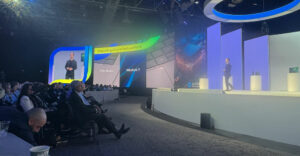
Researchers at the National Institute of Standards and Technology have used microwaves to entangle ions in yet another step toward developing quantum computers.
Quantum entanglement is a feature of quantum physics in which two atoms are linked together in such a way that in order to describe the properties of one, you must describe the properties of the other.
The use of microwaves instead of the normally employed laser beams to entangle the ions indicates that we may be able to shrink down the size of quantum computers.
The microwaves used are similar to those used in smartphones, and NIST speculates that eventually a quantum computer could resemble a smartphone.
However, that doesn’t mean quantum computers using microwave technology will impact smartphones close by “because the qubits, or quantum particles, respond only a particular microwave frequency,” Susumu Takahashi, a professor at the University of Southern California, told TechNewsWorld.
The NIST researchers did not respond to requests for comment by press time.
About the NIST Experiment
This NIST research marks the first time that microwave sources were positioned close enough to the ions to enable entanglement.
An ion is an atom or molecule that has a net positive or negative electrical charge.
The NIST researchers integrated wiring for the microwave sources directly onto a chip-sized ion trap and used a table of lasers, mirrors and lenses that was only about one-tenth the size of previous equipment.
They held two ions with electromagnetic fields. The ions hovered above an ion trap chip consisting of electrodes made from gold-plated aluminum nitride.
The electrodes were activated to create pulses of oscillating microwave radiation in the 1-2 GHz range around the ions. This created magnetic fields used to rotate the ions’ spins. The orientation of the ions is one of the quantum properties used to represent information.
In quantum mechanics, spin is a fundamental characteristic property of elementary particles, composite particles or hadrons, and atomic nuclei.
The ions were entangled by gradually increasing the microwaves’ magnetic fields across them.
The NIST researchers used low-power ultraviolet lasers to cool the ions and observe the results of their experiment. These lasers might be shrunk to the size of the lasers used in portable DVD players.
Trap Technology Explained
An ion trap is a combination of electric or magnetic fields that captures ions in a vacuum system or tube. The Paul, or quadrupole ion, trap, employs constant direct current (DC) and radio frequency oscillating alternating current (AC) fields to trap ions.
The Paul trap’s commonly used as a component of a mass spectrometer, and its use may lead to the development of a trapped ion quantum computer.
A trapped ion quantum computer is based on the fact that ions can be confined and suspended in free space using electromagnetic fields, as was done in the NIST experiment.
Qubits, which are units of quantum information, are stored in the stable electronic states of each ion. Quantum information can be processed and transferred through the collective quantized motion of the ions in the trap.
You apply lasers to induce coupling, or interaction, between the internal qubit states and the external motional states for entanglement between qubits.
Taking It to the People
The use of mass-market technology — microwave electronics similar to that used in smartphones and UV lasers similar to those used in DVD players — may make quantum computers feasible.
“The lasers used in quantum computers will likely be specifically designed for this purpose, but the fact that similar technology has been used in low-cost consumer devices could make the likelihood of a quantum personal computer more likely near-term,” Rob Enderle, principal analyst at the Enderle Group, told TechNewsWorld.






















































The nanotechnology NIST talks about was patented in 1999 by Michael Thomas of
Colossal Storage Corp.